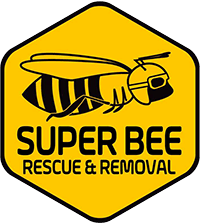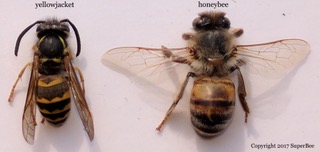If you need help with Yellow Jacket Removal now call Super Bee 805-881-3031
Let’s be real; yellowjackets are just plain mean. It’s as if they enjoy inciting fear and pain in people. Unfortunately, they are often mistaken for honeybees, which are much more docile, friendly insects. In order to clear up any confusion and to make sure you know how to spot and react to yellowjackets, below is some helpful information on this highly defensive critter.
-Origins-
The type of yellowjacket most often observed in the Santa Barbara area is the German yellowjacket (Vespula germanica), also referred to as the European wasp or German wasp. This insect is part of the genus Vespula, which includes other species of social wasps most commonly found in the Northern Hemisphere. The German yellowjacket is not native to North America, as its origins lie in Europe, Asia and North Africa, but today it can be found on just about every continent. In parts of the U.S. with harsh winters, the native common wasp (V. vulgaris) is more commonly found but exhibits very similar characteristics to the German yellowjacket. 2
-Is it a yellow jacket or a honeybee?-
While German yellowjackets (YJs) are stinging pollinators and have black and yellow coloration where as honeybees are more of a black and orange (HBs), there are a few different features between them that can help you identify the difference. Helpful pictures are above.
- YJs have a lot less hair on their bodies than HBs do.
- YJs have a less rounded abdomen than HBs.
- YJs have longer, narrower wings than those of HBs.
- YJs do not have an expandable hind leg to carry pollen like HBs do.
- YJs do not have a barbed stinger like the HB, so they can sting repeatedly without dying.
- Yjs have a skin wasp waist
If you have a bee hive click here for details.
-Where do they like to build nests?-
YJs often like to nest underground, although you can also find aerial nests, like in a tree, or nests in buildings, such as in “wall voids, drop ceilings, attics, and voids in concrete block.” 1
-How do YJs reproduce?-
A YJ colony begins with a single queen. A mother colony will produce many queens, which will mate with male YJs in the fall, hibernate with their fertilized eggs in winter, then go out in the spring to start a new colony. She will begin by building a papery nest (which is why they are sometimes confused for paper wasps) made of many hexagonal cells. She then fills those cells with her eggs and is solely responsible for feeding them and taking care of them. A new YJ colony is most vulnerable in early spring for this reason, as it takes a lot of time and energy for the queen to raise her new colony and make it strong. Older colonies also start out weaker earlier in the year as workers and males die off during winter. 2
-What do YJs eat?-
As they are scavengers and hunters, they have a very diverse diet composed of nectar, dead organisms, live arthropods, fruit, and processed human food and garbage. Because they feed on nectar, they do have one redeeming quality: they help pollinate plants! 2
-How can I prevent YJs from coming near me and my home?-
YJs are usually nearby because you have or are near a food source. To prevent contact, cut off any food sources by keeping food in enclosed containers if outside, covering garbage cans, etc.
You can also place traps near the edges of your property to lure them away from your home instead of to your home. Here is a trap we recommend: Yellow Jacket Trap on Amazon
The yellow jacket traps have good instructions in the packaging suggest 4 traps per acre. For bad problems suggest 10 plus traps. The traps need to be emptied and rebaited every 10 weeks from Valentines day through Holloween.
-What do I do if I encounter a YJ nest?-
If you encounter a YJ nest, here are some helpful steps to take to prevent you and others from getting stung:
- Step away from the nest! YJs are especially defensive of their hive, so the closer you are to the hive, the more likely you are to get stung.
- Inform others nearby of the nest’s presence.
- Call Super Bee or another pest control company to come get rid of the nest ASAP.
- **DO NOT try to mess with the nest yourself. Upsetting yellow jackets without the proper protective gear will just get you into trouble.**
-Our Method-
Here at Superbee, we don’t like nasty chemicals. So, we choose to tackle Yellow jacket problems with just Dawn dish soap and water. If you’re having a YJ problem, we’ll spray them down with soapy water, remove the nest, set a trap, and make sure that no future YJs will be attracted to the area, all while wearing a full bee suit. We also will make a return visit to check up on the site.
We charge a total of $400 for a Yellowjacket removal, including the return check-up visit. Especially complicated or dangerous jobs could be more expensive. If you are interested in our services, please call 805-684-9999.

